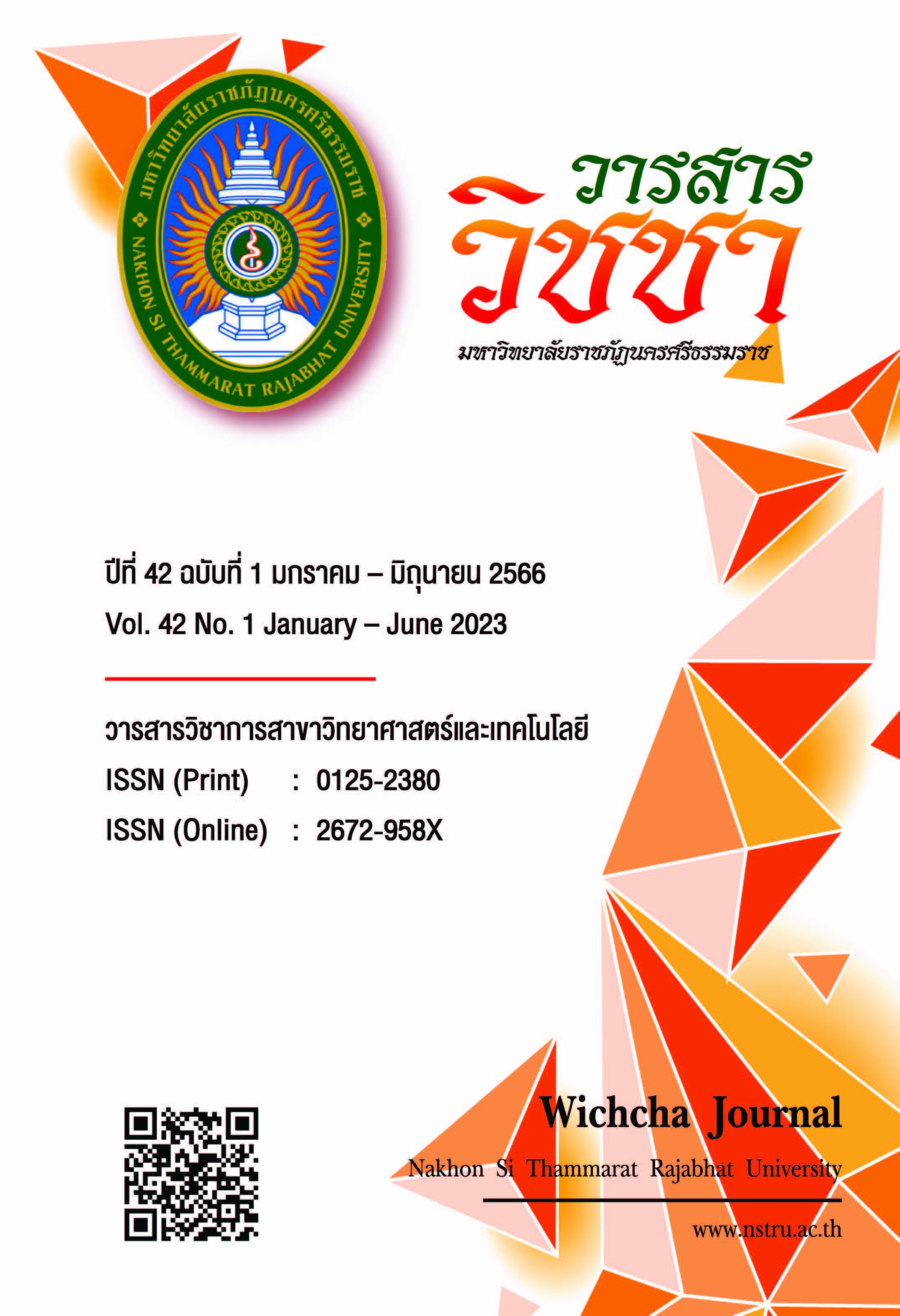Effect of Zinc Foliar Application on Yield and Zinc Concentration of Galangal
Main Article Content
Abstract
A nutritious eating is important for all ages. The body should get enough nutrients to meet its needs, but most people eat unhealthy foods such as instant foods at risk of zinc deficiency. The objective of this research was to study the accumulation of zinc in galangal. The experiment used randomized complete block design (RCBD) with 5 treatments and 5 replications. The treatments were consisted of non-zinc applied (control) and zinc foliar applied concentration at a rate 2.5, 5.0, 7.5, and 10.0 grams per litre. The young galangal products were collected at 6 months and old galangal at 12 months. The results showed that the rate of zinc supplementation increased galangal growth and yield compared with the control. In the amount of zinc, young and old galangal given zinc supplementation at the concentration of 10 grams per litre had the highest zinc accumulation rate of 131.87 and 96.87 milligram per kilometer. The fresh weight yield showed that young galangal supplemented with zinc 7.5 grams per litre had the highest fresh weight yield of 903.00 grams, and old galangal (control) had the fresh weight yield of 1057.25 grams. The dry weight content of young and old galangal (controls) had the highest zinc accumulation rates of 80.84 and 152.33 grams. Therefore, the optimum foliar spraying rate of zinc in both quantities, fresh weight yield and zinc accumulation in young galangal, was 7.5 grams per litre.
Article Details

This work is licensed under a Creative Commons Attribution-NonCommercial-NoDerivatives 4.0 International License.
เนื้อหาและข้อมูลในบทความที่ลงตีพิมพ์ในวารสารวิชชา มหาวิทยาลัยราชภัฏนครศรีธรรมราช ถือเป็นข้อคิดเห็นและความรับผิดชอบของผู้เขียนบทความโดยตรง ซึ่งกองบรรณาธิการวารสารไม่จำเป็นต้องเห็นด้วยหรือร่วมรับผิดชอบใด ๆ
บทความ ข้อมูล เนื้อหา รูปภาพ ฯลฯ ที่ได้รับการตีพิมพ์ในวารสารวิชชา มหาวิทยาลัยราชภัฏนครศรีธรรมราช ถือเป็นลิขสิทธ์ของวารสารวิชชา มหาวิทยาลัยราชภัฏนครศรีธรรมราช หากบุคคลหรือหน่วยงานใดต้องการนำข้อมูลทั้งหมดหรือส่วนหนึ่งส่วนใดไปเผยแพร่ต่อหรือเพื่อการกระทำการใด ๆ จะต้องได้รับอนุญาตเป็นลายลักษณ์อักษรจากวารสารวิชชา มหาวิทยาลัยราชภัฏนครศรีธรรมราชก่อนเท่านั้น
The content and information in the article published in Wichcha journal Nakhon Si Thammarat Rajabhat University, It is the opinion and responsibility of the author of the article. The editorial journals do not need to agree. Or share any responsibility.
References
พลอย วงวิไลย. (2561). Zinc แร่ธาตุสังกะสี สารอาหารสำคัญ ประโยชน์ครบครัน ของสุขภาพ. สืบค้นเมื่อ 9 ตุลาคม 2565, จาก: https://www.megawecare.co.th/content/5462/zinc-essential-nutrient-for-health-.
พัชรินทร์ ตุ้ยวงค์ เพ็ญนภา จักร์สมศักดิ์ เบญจวรรณ ฤกษ์เกษม และชนากานต์ เทโบลต์ พรมอุทัยผล. (2558). ผลของการพ่นสังกะสีที่ใบต่อผลผลิตและการสะสมธาตุสังกะสีในข้าวกล้องของข้าวพันธุ์พื้นเมืองและพันธุ์ปรับปรุง. วารสารแก่นเกษตร, 43(4), 605-612.
พัชรี เดชเลย์ คมกฤษณ์ แสงเงิน ณัฐพงค์ จันจุฬา และอนันต์ พิริยะภัทรกิจ. (2565). ผลของปุ๋ยหมักจากต้นกล้วยหอมทองเสริมซีลีเนียมต่อการเจริญเติบโตผลผลิต และปริมาณซีลีเนียมของผักกาดหอม. วารสารวิชชา มหาวิทยาลัยราชภัฏนครศรีธรรมราช, 41(1), 15-24.
ยงยุทธ โอสถสภา อรรถศิษฐ์ วงศ์มณีโรจน์ และชวลิต ฮงประยูร. (2554). ปุ๋ยเพื่อการเกษตรยั่งยืน. (พิมพ์ครั้งที่ 2). กรุงเทพฯ: มหาวิทยาลัยเกษตรศาสตร์.
เสนาะ ขาวขำ เทวัญ ธานีรัตน์ และพระปลัดสมชาย ปโยโค (2560). การใช้สมุนไพรตามพุทธานุญาตเพื่องานสาธารณสุขมูลฐาน. วารสารสันติศึกษาปริทรรศน์ มจร, 5(2), 237-249.
เอกชัย เรืองดำ (2560). สังกะสี แร่ธาตุที่ต้องการน้อยแต่สำคัญ. วารสารกรมวิทยาศาสตร์บริการ, 65(204), 24-25.
Dore, V., Koti, R.V. and Math, K.K. (2018). Response of zinc application on growth, zinc content and grain yield of rice genotypes and correlation between zinc content and yield attributes of rice genotypes. Indian Journal of Animals Research, 52(6), 625-630, doi: https://doi.org/10.18805/IJARe.A-5096.
Fu, X.Z., Xing, F., Cao, L., Chun, C.P, Ling, L.L, Jiang, C.L. and Peng, L.Z. (2016). Effects of foliar application of various zinc fertilizers with organosilicone on correcting citrus zinc deficiency. HortScience, 51(4), 422-426, doi: https://doi.org/10.21273/HORTSCI.51.4.422.
Heinemann, A.B., Stone, L.F. and Fageria, N.K. (2011). Transpiration rate response to water deficit during vegetative and reproductive phases of upland rice cultivars. Agricultural Science Journal, 68(1), 24-30, doi: https://doi.org/10.1590/S0103-90162011000100004.
Hotz, C. and Brown, K.H. (2004). Chapter 2: Assessment of the risk of zinc deficiency in populations and options for its control. Food and Nutrition Bulletin, 25(1), 99-203, doi: https://doi.org/10.1177/15648265040251S.
Maret, W. (2013). Zinc biochemistry: From a single zinc enzyme to a key element of life. Advance in Nutrition Journal, 4(1), 82-91, doi: https://doi.org/10.3945/an.112.003038.
McLean, E., Cogswell, M., Egli, I., Wojdyla, D. and De Benoist, B. (2008). Worldwide prevalence of anaemia, WHO vitamin and mineral nutrition information system, 1993-2005. Public Health Nutrition, 12(4), 444-454, doi: https://doi.org/10.1017/S1368980008002401.
Noulas, C., Tziouvalekas, M. and Karyotis, T. (2018). Zinc in soils, water and food crops. Journal of Trace Element in Medicine and Biology, 49, 252-260, doi: https://doi.org/10.1016/j.jtemb.2018.02.009.
Phitak, T., Choocheep, K., Pothacharoen, P., Pompimon, W., Premanode, B. and Kongtawelert, P. (2009). The effects of p-hydroxycinnamaldehyde from Alpinia galanga extracts on human chondrocytes. Phytochemistry, 70(2), 237-243, doi: https://doi.org/10.1016/j.phytochem.2008.11.010.
Saenchai, C., Prom-u-thai, C., Jamjod, S., Dell, B. and Rerkasem, B. (2014). Iron and zinc partitioning in rice grain. Khon Kaen Agriculture Journal, 43(1), 67-78.
Saito, H., Cherasse, Y., Suzuki, R., Mitarai, M., Ueda, F. and Urade, Y. (2017). Zinc-rich oysters as well as zinc yeast and astaxanthin enriched food improved sleep efficiency and sleep onset in a randomized controlled trial of healthy individuals. Molecular Nutrition and Food Research, 61(5), 16-82, doi: https://doi.org/10.1002/mnfr.201600882.
Shu, N., Zhou, T. and Hovmoller, S. (2008). Prediction of zinc-binding sites in proteins from sequence. Journal Article, 24(6), 775-782, doi: https://doi.org/10.1093/bioinformatics/btm618.
Wissuwa, M., Ismail, A.M. and Graham, R.D. (2008). Rice grain zinc concentrations as affected by genotype, native soil-zinc availability and zinc fertilization. Plant and Soil, 306(1), 37-48, doi: https://doi.org/10.1007/s11104-007-9368-4.


